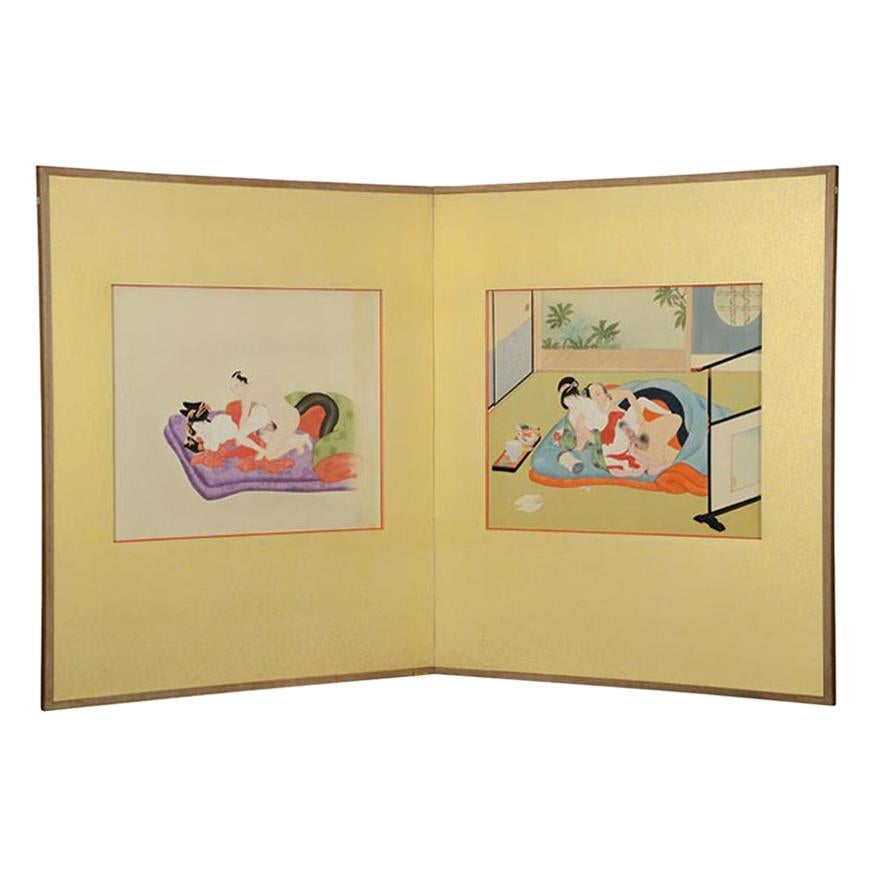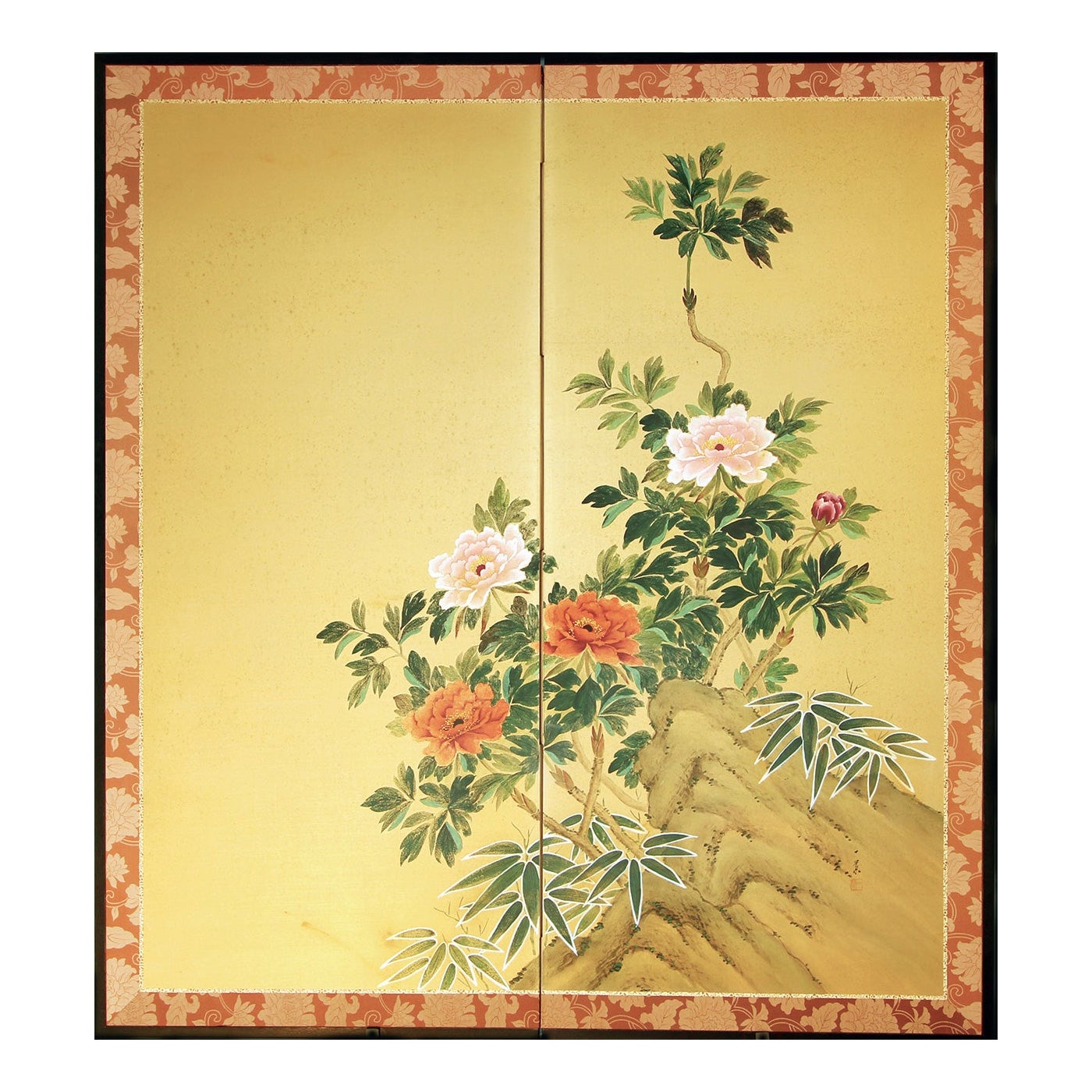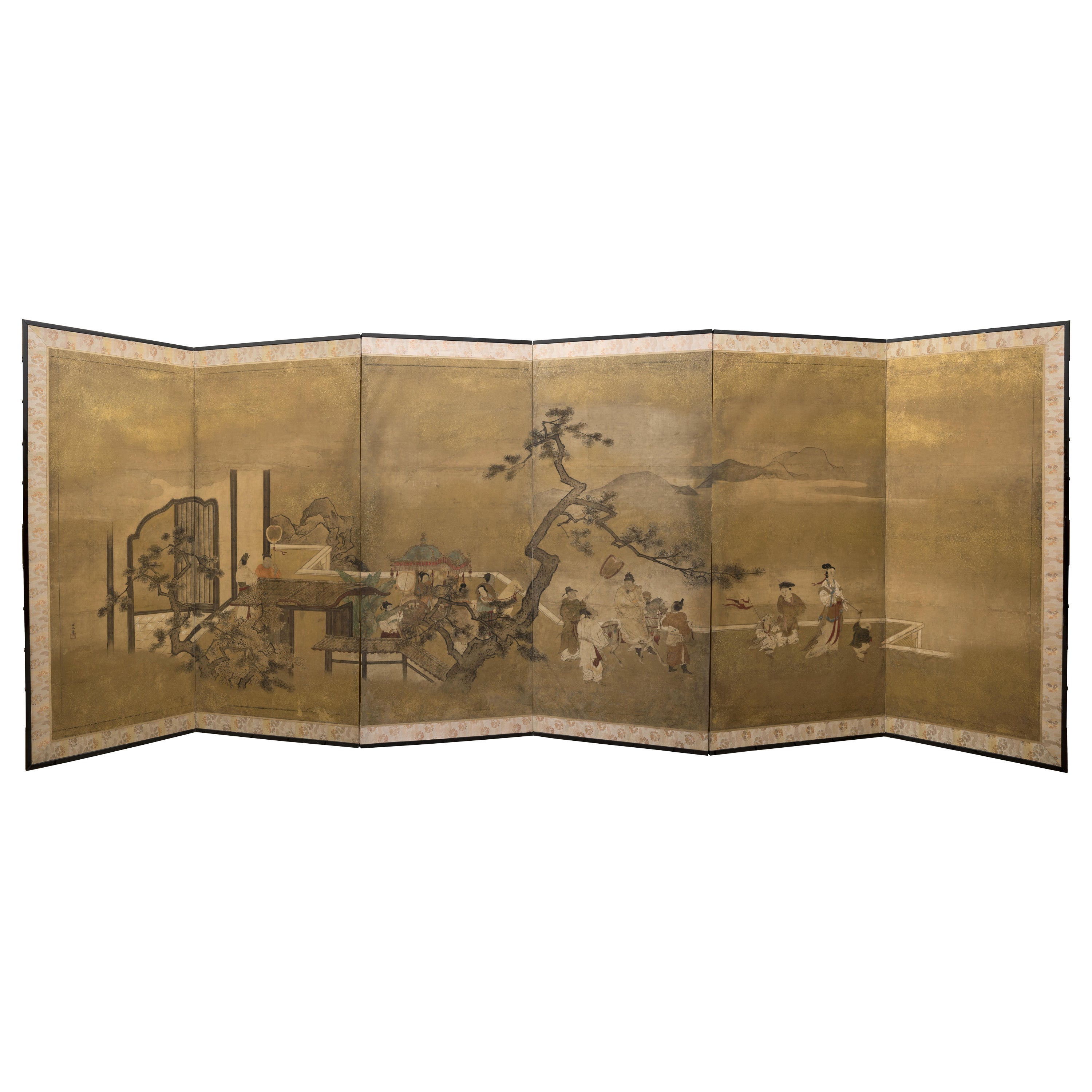Items Similar to Japanese Screen Depicting USA Commodore Perry’s Flagship the USS Mississipi
Want more images or videos?
Request additional images or videos from the seller
1 of 3
Japanese Screen Depicting USA Commodore Perry’s Flagship the USS Mississipi
About the Item
A rare and fine Japanese six-fold gold-leaf screen with the depiction of Commodore Matthew Perry’s flagship the USS Mississippi
Early Bakumatsu period (1853-1867)
Measures: H. 61 x W. 183 cm
Provenance:
Private collection, USA
On 8 July 1853 Commodore Matthew Perry with his paddle-wheel warships USS Mississippi and Susquehanna, and two sloops, with a total of 65 guns and little less than 1000 man, for the first time arrived in the harbour of Shimoda, in the bay of Edo, in his own words, “to open doors of commerce, and spread civilization to a backward people, and also to spread the Gospel of God to the heathen.” In Japanese parlance, the American ships quickly became known as “black ships,” depicted as demonic monsters. For the Japanese, these huge coal-burning ships with black hulls and belching black smoke out of their funnels probably were Darkness Incarnate. In the present
Japanese depiction of Perry’s ship not only the hull and the smoke are pitch black, but also the figurehead on the bow is a leering monster, the portholes high in the stern glow like eyes of an apparition, the ship’s sides bristle with rows of cannon, and gunfire streaks like a searchlight from guns at both sides of the ship.
?Perry remained in the Edo Bay until the Japanese accepted an official letter by President Millard Fillmore. In 1854 Perry returned with a fleet of nine ships on his flagship Mississippi and remained in Edo Bay as part of his show of force until the signing of the Convention of Kanagawa on 31 March 1854.
?In 1841 the USS Mississippi, built under the personal supervision of Perry, was launched and became Perry’s first steam-driven frigate and flagship. She was involved in many US Navy operations until she ran aground and was destroyed in 1863 during an attack against Port Hudson, Louisiana, during the American Civil War.
- Dimensions:Height: 23.63 in (60 cm)Width: 72.05 in (183 cm)Depth: 1.58 in (4 cm)
- Materials and Techniques:
- Place of Origin:
- Period:
- Date of Manufacture:1860-1870
- Condition:Wear consistent with age and use.
- Seller Location:Amsterdam, NL
- Reference Number:1stDibs: LU5458226435932
About the Seller
5.0
Vetted Seller
These experienced sellers undergo a comprehensive evaluation by our team of in-house experts.
Established in 1985
1stDibs seller since 2020
19 sales on 1stDibs
Typical response time: 3 hours
- ShippingRetrieving quote...Ships From: Amsterdam, Netherlands
- Return PolicyThis item cannot be returned.
More From This SellerView All
- Japanese Painting Depicting Commodore Perry’s Ship with Buddhist Monks AboardLocated in Amsterdam, NLA Japanese painting depicting Commodore Matthew Perry’s flagship USS Mississippi bringing the coffin with the remains of US marine private Robert Williams who died while serving on t...Category
Antique Mid-19th Century Japanese Edo Paintings and Screens
MaterialsPaint, Paper
- Important Japanese six-fold screen depicting The Tale of The Genji, 17th centuryLocated in Amsterdam, NLAn important Japanese six-fold screen, depicting episodes from The Tale of The Genji Edo period, 17th century Ink and colour on gilded paper, H. 155 x W. 380 cm The Tale of Genji...Category
Antique 17th Century Japanese Edo Paintings and Screens
MaterialsPaint, Paper
- Centre Table Commemorating the Paris Treaty and the USA Independence, Dated 1886Located in Amsterdam, NLA very interesting centre table commemorating the Paris Treaty between the original thirteen states of the United States of America and Great Britain ending the American Revolution o...Category
Antique Late 19th Century American Directoire Center Tables
MaterialsBone, Wood
- Chinese Export Trade Painting Depicting ‘the Tea Shop', Chinoiserie ChiqueLocated in Amsterdam, NLA refined Chinese export painting depicting ‘The Tea shop’ Canton, early 19th century Ink and watercolour on silk, H. 63.5 x W. 52.3 cm Framed in giltwood frame. ?The paintin...Category
Antique Early 19th Century Chinese Chinese Export Paintings and Screens
MaterialsSilk
- An Indian miniature painting depicting a prince surprising bathing maidensLocated in Amsterdam, NLIndia, Punjab, circa 1755 Signed by the artist Swami 'Ram Rikh' of Seopur and dated Samvat 1812 (1755) Opaque watercolour and gold on paper, H. 23.8 x W. 16.2 cm (image) H. 28.3 x ...Category
Antique 18th Century Indian Paintings and Screens
MaterialsGold
- Collection of Colonial Drawings Depicting Indonesia by J.G. Sinia '1875-1948'Located in Amsterdam, NLA Collection of Thirteen Ink and Chalk Drawings by Johan Gerard Sinia (1875-1948) All framed in gilt-metal or giltwood frames Sinia started his professional career as an army off...Category
Early 20th Century Indonesian Dutch Colonial Paintings and Screens
MaterialsOther
You May Also Like
- Japanese 2-Panel 'Shunga' Screen with Finely Painted Erotic Depictions of LoversLocated in Prahran, VictoriaA very finely painted two panel 'shunga' screen with scenes of naked erotic lovers in union. The scene on the left panel simply depicts the lovers in ...Category
Mid-20th Century Japanese Showa Paintings and Screens
MaterialsWood, Paper
- Japanese screenBy Japanese StudioLocated in Brescia, ITTwo-panel screen of Rinpa school painted with mineral pigments on silk and rice paper. It depicts colorful peony flowers. This is the flower of spring, symbolizing success and pro...Category
20th Century Japanese Showa Paintings and Screens
MaterialsSilk, Paper
- Japanese Screen "the Song of Everlasting Sorrow"Located in PARIS, FRSix-panels screen depicting the exit from the city of a Chinese emperor on horseback and his concubine in a luxurious palanquin. It may be a scene illustrating the poem The Song ...Category
Antique Late 17th Century Japanese Paintings and Screens
MaterialsWood, Paper, Silk
- Japanese Two Panel Screen Chrysanthemums Through the Mist Obara Art ScreenLocated in Hudson, NYJapanese two panel screen: Chrysanthemums Through the Mist Obara Paper Art Screen. Surreal and masterful rendering of chrysanthemums cloaked in mist that varies in opacity made entirely of carefully arranged mulberry paper fibers in a Japanese art practice called Obara. Accented with gold leaf. Unique in terms of both execution and dreamlike mood. Made by Yamauchi Issei (b. 1929), stamped in the corner. Issei is well known throughout Japan as the leading artist in Obara Paper Art. Starting in 1948, he apprenticed with Fuji Tatsukichi, a leading proponent of the arts and crafts movement in Japan who worked to revive many cultural traditions on the brink of extinction. Issei started exhibiting in the Nitten in 1953, won the gold medal in 1963, and eventually became a juror. His artwork was given as a gift to the Showa Emperor of Japan, as well as dignitaries such as General Douglas MacArthur...Category
Mid-20th Century Japanese Showa Paintings and Screens
MaterialsPaper, Wood
- Four-panel Japanese Byobu Folding Screen depicts a scene of Egrets, 20th CenturyLocated in Savannah, GAFour-panel Japanese Byobu folding screen depicting a scene of Egrets resting in a forest. The dark, rich colors, gold leaf, and beautiful hand-painted detail really make this an att...Category
Early 20th Century Japanese Paintings and Screens
MaterialsGold Leaf
- Japanese Six Panel Screen: Egrets in the RainLocated in Hudson, NYJapanese Six Panel Screen: Egrets in the Rain Mineral pigments on mulberry paper with tones of silver in the foreground Signed and sealed 北遥 Hokuy...Category
Vintage 1930s Japanese Paintings and Screens
Recently Viewed
View AllMore Ways To Browse
Antique Furniture Usa
Japanese Screen Black
Screen Doors Used
19th Japanese Screens
Six Fold
Antique Japanese Doors
Asian Black Screens
Used Screen Doors
Paper Folding Screen
Papered Folding Screen
Asian War
1860 Japan
Japanese Painting Gold Black
Japanese Folding Screen Screen
19th Gun
Japan Folding Screens
19th Century Folding Screen
Civil War Memorabillia





